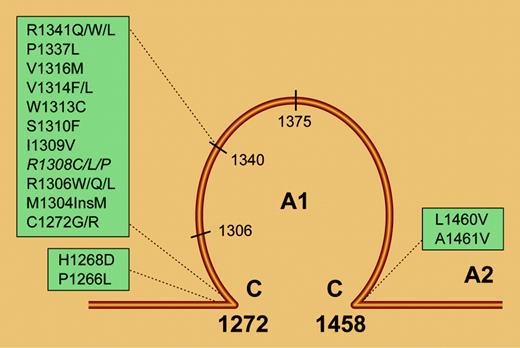Comment on Nurden et al, page 2587
In this issue, Nurden and colleagues provide evidence that the severe thrombocytopenia found in a family with type 2B von Willebrand disease (VWD) is due also to impaired megakaryocytopoiesis, as shown both by changes in proteins involved in platelet calcium homeostasis and by electron microscopy (EM).
Type 2B von Willebrand disease (VWD) is an inherited bleeding disorder characterized by enhanced ristocetin-induced platelet agglutination (RIPA) in a patient's platelet-rich plasma1,2 and is due to a group of mutations clustered within von Willebrand factor (VWF) A1 domain (see figure at bottom left). The mutant type 2B VWF displays increased affinity to its platelet receptor, the glycoprotein Ibα (GPIbα). The gain of function in the VWF A1 domain creates 3 conditions that explain bleeding at the sites of injury: (1) the large, hemostatically most effective VWF multimers are decreased in plasma; (2) platelet count may be reduced; and (3) part of the GPIbα receptors may be occupied by soluble VWF and unable to interact with VWF immobilized on the tissues exposed at the sites of injury.2 The plasma VWF multimeric pattern and the degree of thrombocytopenia can vary significantly in patients with type 2B VWD.2,3 A wide degree of heterogeneity has been found in the VWF multimeric patterns, ranging from the complete loss of the high-intermediate multimers to the partial preservation of the larger VWF forms (see figure at top right). Mild to severe thrombocytopenia especially following physiologic or pathologic stress conditions such as pregnancy, infections, surgery, or use of desmopressin can be observed, while cases with severe thrombocytopenia with platelet agglutinates at baseline are very rare.2 Severe thrombocytopenia with giant platelets has been also reported.4
Summary of the main mutations associated with type 2B VWD. Note that they are all included within the VWF A1 domain. Illustration by Frank Forney.
Summary of the main mutations associated with type 2B VWD. Note that they are all included within the VWF A1 domain. Illustration by Frank Forney.
Nurden and colleagues report for the first time a family with type 2B VWD in which severe thrombocytopenia is also due to abnormal megakaryocytopoiesis. The affected members of this family carry a heterozygous mutation in the VWF A1, resulting in R1308P substitution. The net result is in vivo platelet agglutination and severe thrombocytopenia. Electron microscopy (EM) demonstrated that agglutinates were composed of rounded platelets with distinct zones of contact confirming a major role of the enhanced type 2B VWF-GPIb binding. Abnormal megakaryocytopoiesis was also involved, because plasma membrane Ca2+ ATPase and inositol triphosphate receptor were selectively increased. Moreover, findings typical of immature megakaryocytes (MKs), cultured from peripheral blood CD34 cells in the presence of TPO, were observed. Immunolocalization showed VWF not only associated with platelets, but already on the MK surface and within internal channels. Specific amino acid substitutions in the VWF A1 domain are critical, since other affected VWD patients with R1308L showed normal platelet count and no significant loss of the largest multimers.5 These studies open novel research approaches to explore basic mechanisms on type 2B VWD and on megakaryocytopoiesis. However, since platelet counts can be normal in 2B VWD, more 2B cases with thrombocytopenia should be investigated to better understand if these findings are the exception or the rule. The relevance of VWF A1-GPIb interactions influencing megakaryocytopoiesis is a novel observation likely to produce new insights into platelet production.
Multimeric structure of plasma VWF in selected patients with type 2B VWD and different VWF mutations as obtained by low-resolution SDS agarose gel electrophoresis. Two normal samples (NP) are shown for comparison. The cathode is at the top of the figure, and the direction of electrophoretic migration is from top to the bottom. Adapted from Federici et al.3
Multimeric structure of plasma VWF in selected patients with type 2B VWD and different VWF mutations as obtained by low-resolution SDS agarose gel electrophoresis. Two normal samples (NP) are shown for comparison. The cathode is at the top of the figure, and the direction of electrophoretic migration is from top to the bottom. Adapted from Federici et al.3
Dr. Federici is Associate Professor of Hematology at the University of Milan School of Medicine. ▪



This feature is available to Subscribers Only
Sign In or Create an Account Close Modal